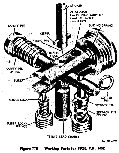How a mortar fuze works. (simplified)
Written: 7/18/2007
Editor: Drew Ballard
Written using the M52 fuze as an example.
It's easier to understand the functioning of a mortar fuze by first working backwards.
To detonate, the Firing Pin strikes the Detonator which ignites the Tetryl Lead Charge, exploding the shell.
What stops the Firing Pin from doing this before it is supposed to? You can see from the above illustration that the Slider is not in the correct position for the Detonator to be hit.
What stops the Slider from being in the correct position? The Safety Pin will not allow the Slider to move over until it is withdrawn.
What stops the Safety Pin from being withdrawn? The Setback Pin rests in a hole in the Safety Pin until the Setback Pin is withdrawn. Also, the Safety Pin can not be fully removed until the shell leaves the barrel of the mortar.
What moves the Setback Pin? It's held in place by it's spring and the friction of the Safety Pin. The Setback Pin is withdrawn when the shell is instantly accelerated upon ignition of the propelling charge. Also, as a safety measure, the Setback Pin is held in place with the Safety Wire, or in the case of the illustration, a cotter pin.
So, in forward order:
The Saftey Wire is pulled off of the fuze.
The shell hits the firing pin in the mortar and is ignited with the sudden acceleration withdrawing the Setback Pin.
The Safety Pin is the ejected due to its spring. It rides against the barrel and is fully ejected once the shell leaves the barrel.
The Slider is then moved into the correct position due to its spring. The fuze is now fully armed.
When the nose impacts, the Firing Pin strikes the Detonator, setting off the charge.
Is it possible to arm the fuze by hitting the base of the shell on the ground? Yes. Several WW2 Medal of Honor citations specifically mention this. If the Safety Wire is removed, and the base of the shell is hit on the ground VERY HARD, the Setback Pin may be withdrawn. There is quite a bit of friction as the Safety Pin is under spring pressure and the Setback Pin has a spring of its own.
The shell must be slammed down very hard as hitting it on the ground is much less than the acceleration of ignition. This is evidenced by the fact that the mortar baseplate is driven deeper into the ground after several firings. You would never have this effect by striking the shell on the baseplate. Note, none of this matters if the nose of the fuze doesn't strike the ground when thrown.
For some great photos please see Inert-Ord.net. If asked to login, Username: open, Password: 1945.
90th IDPG Weapons



